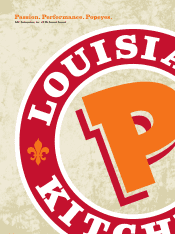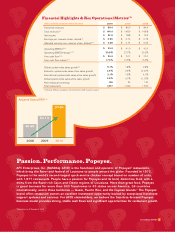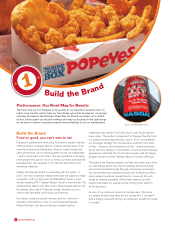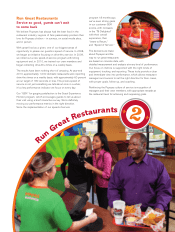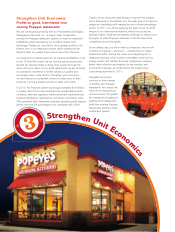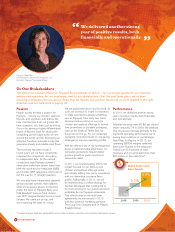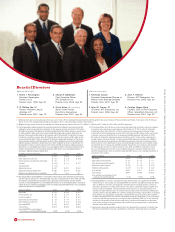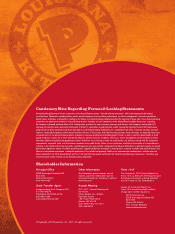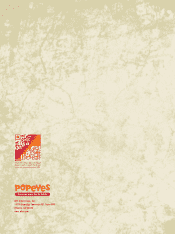Popeye's 2010 Annual Report Download - page 5
Download and view the complete annual report
Please find page 5 of the 2010 Popeye's annual report below. You can navigate through the pages in the report by either clicking on the pages listed below, or by using the keyword search tool below to find specific information within the annual report.
AFC ENTERPRISES, INC.
4
Strengthen Unit Economics
Profits so good, franchisees love
owning Popeyes restaurants
We are continually partnering with our franchisees and Supply
Management Services, Inc., a supply chain cooperative
serving the Popeyes restaurant system, to improve restaurant
profi tability while maintaining our excellent quality food
advantage. Simply put, we want to drive greater profi ts to the
bottom line of our restaurant owners while maintaining the
fl avorful taste our guests have come to love from Popeyes.
Our approach is multipronged, as we improve profi tability on all
fronts. To build the brand, we are running special promotions
backed by national media to bring more guests through the
doors and grow sales. To run great restaurants, we are focusing
on operations excellence to better satisfy our guests and
encourage return visits. And to strengthen unit economics,
we are helping our restaurant owners to keep more of their
revenues, turning a greater portion of sales into profi ts.
In 2010, the Popeyes system saved approximately $16 million
in supply-chain food costs resulting from renegotiated vendor
contracts, alternate suppliers, enhanced product specifi cations,
logistics/distribution optimization, and lower commodity costs.
This combined effort improved restaurant operating profi t margins
before rent one full percentage point compared with 2009.
Clearly, we are doing the right things to improve the margins
we’re delivering to franchisees. Our fi ve-year goal is to improve
restaurant operating profi t margins by two to three percentage
points. In 2011, we will be applying the same focus on profi t
margin to our international markets, where food costs are
typically higher. Initiatives are already underway to reduce cost
by region to make Popeyes’ restaurant cost structure more
competitive around the globe.
As we always say, you move what you measure. And we will
continue to measure – and move – contributions to higher
restaurant profi ts. Among the areas we’re targeting are in-
restaurant savings, which involve controllable costs such as
energy, waste, and utilities; business intelligence, meaning
better data collection and analysis for key metrics; and
procurement savings, as evidenced by the supply-chain
cost savings achieved in 2010.
Favorable economics
continue to drive interest
in building new Popeyes
restaurants. As a result, the
more we’ve improved our
unit economics, the greater
the interest we’re getting in
building more restaurants –
both from existing Popeyes
franchisees and from other
multi-brand owners.
3
S
t
r
e
n
g
t
h
e
n
U
n
i
t
E
c
o
n
o
m
i
c
s

